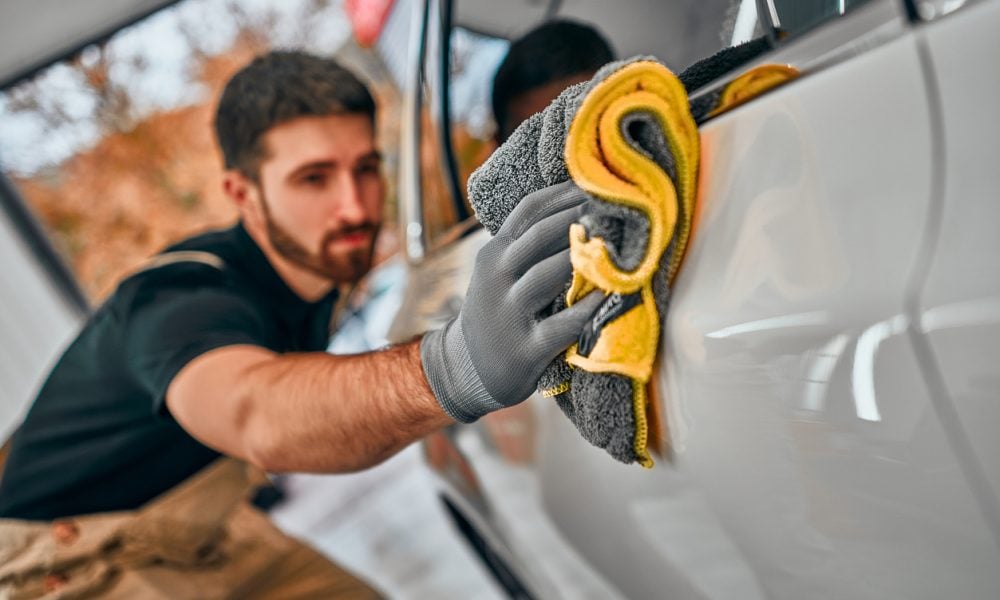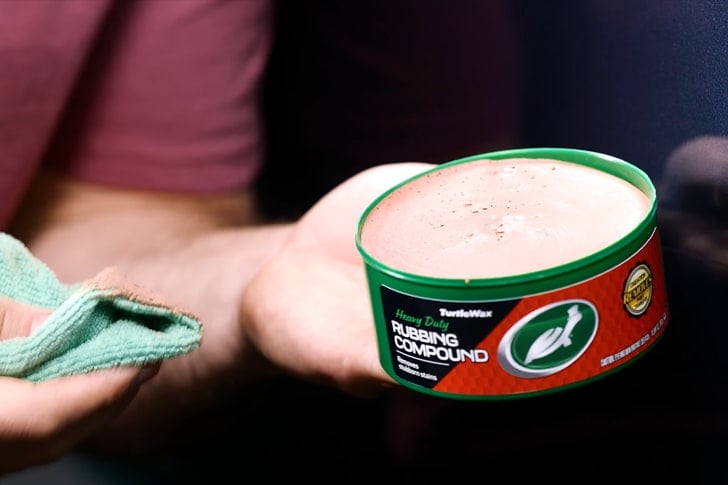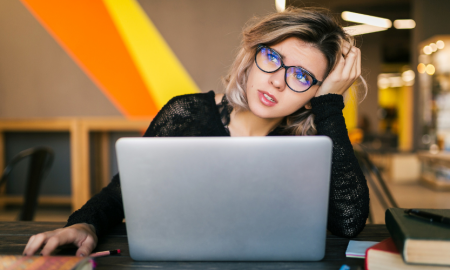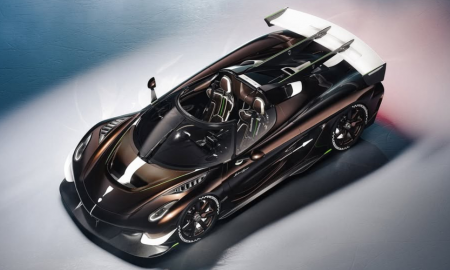
How to Use Rubbing Compound to Remove Car Scratches

Scratches and cracks on a vehicle can be a common but unwelcome sight for any car owner. Despite careful driving, these imperfections can occur and detract from the aesthetic appeal of your vehicle. Fortunately, with the help of a rubbing compound, you can tackle these blemishes head-on. This guide will explore the effective use of rubbing compound to restore your car’s paintwork.
What Is Rubbing Compound?

Christine Mae / Facebook
Rubbing compound, often regarded as a pivotal solution in the auto detailing industry, is a specially formulated product designed to tackle surface imperfections on vehicles, such as scratches, scuffs, and oxidization. This compound works by gently abrading the top layer of the car’s paint, essentially “sanding” down the imperfections to create a smoother surface. The abrasive nature of the compound is graded in various levels of coarseness, tailored to address different degrees of surface damage.
What Is Rubbing Compound Made Of?
Rubbing compounds are made from a blend of abrasive materials suspended in a paste or liquid. The abrasive materials can range from aluminum oxide to synthetic ceramics, each offering different levels of abrasiveness for various repair needs. Generally, these compounds are categorized into coarse, medium, and fine grades, with coarse compounds used for more significant damage and fine compounds for light scratches and finishing touches.
How Does Rubbing Compound Work?

Turtle Wax / Youtube
The principle behind the rubbing compound’s effectiveness lies in its abrasive components. When applied to the paintwork, these abrasive particles microscopically wear away the paint’s surface layer, removing the damaged part of the paint and diminishing the visibility of scratches. This process is often referred to as “leveling” or “cutting” the paint, terms commonly used by professionals in the automotive repair and detailing industry.
Steps to Use Rubbing Compound
Step 1. Preparing Your Vehicle

Motomax India / Youtube
Before applying the rubbing compound, ensure the car is thoroughly cleaned with automotive-grade soap to remove any dirt, grime, or debris. Consider using a clay bar on the area to eliminate any surface contaminants. This preparation step ensures the compound works directly on the scratches without interference from dirt or dust.
Step 2. Applying The Rubbing Compound

Motomax India / Youtube
Choose the right car cleaning products based on the severity of the scratches. For minor scratches, a clean microfiber towel may suffice. For deeper imperfections, using a polisher with an appropriate pad can yield better results. When applying the rubbing compound, it’s crucial to use circular motions to buff out the scratches, applying the compound evenly across the affected area. It’s advisable to work in small sections to maintain control and ensure an even application.
Step 3. Buffing The Surface

Motomax India / Youtube
After applying the rubbing compound, allow it to dry as per the product’s instructions, usually taking a few minutes. Use a clean microfiber cloth to buff the surface, removing any excess compound and revealing a smooth, polished finish. Inspect your work and repeat the process if needed to achieve the desired level of finish.
Step 4. Choosing The Right Compound

Jam Dalida / Facebook
The choice of rubbing compound depends on the condition of your paint and the severity of the scratches. Lighter compounds are suitable for minor imperfections, while more abrasive compounds are needed for deeper scratches or more significant damage. Always ensure that the compound you choose is compatible with your car’s paint type to avoid potential damage.
Step 5. Finishing Up

AMMO NYC / Youtube
After applying the rubbing compound and achieving a satisfactory result, it’s recommended to follow up with a polish to enhance the shine and provide additional protection to the treated area. This final step helps in restoring the gloss and reflection of your car’s paintwork (DIY Auto Restoration).
Additional Tips
To make the most out of using a rubbing compound for car care, it’s essential to understand its applications, best practices, and common pitfalls. Here’s an enhanced guide with additional tips gathered from various expert sources:
Choosing the Right Rubbing Compound
The selection of a rubbing compound should be based on the condition of your vehicle’s paint. Light rubbing compounds are ideal for vehicles with dull finishes but no significant scratches or dents, revitalizing the paint to top condition. In contrast, abrasive compounds are suited for vehicles with numerous scratches and mild dents. For deep dents and scratches, a machine application of the compound is recommended, though hand applications can be effective for less severe jobs. It’s crucial to select a rubbing compound that matches the level of damage to avoid further damage to the paintwork.
Application Techniques
By Hand: Applying rubbing compound by hand is an effective method for addressing non-deep blemishes and light scratches. This method requires a synthetic (microfiber) cloth and a significant amount of elbow grease, applying pressure in a clockwise manner to ensure the blemishes are completely removed.
Using a Machine: An orbital buffer can produce more efficient results than manual application, especially for deeper scratches. This method involves setting the buffer at a low-medium speed and moistening the wool pad before adding the rubbing compound. The buffer automates the movement, requiring you only to guide its operation.
Preparing the Car

Vermijl Car Detail / Youtube
Before applying the rubbing compound, wash your car thoroughly to remove any dirt, dust, or debris. Dry the car completely, inspect for any deeper scratches that may need more intensive treatment, and mask off areas you don’t want to treat with the compound. Use a foam pad or cloth to apply the rubbing compound in small sections, ensuring an even application and preventing compound buildup. After treating the entire car, wash it again to remove any residue, and consider following up with polishing or waxing to enhance the shine and protect the surface.
Common Mistakes to Avoid
• Failing to read the product instructions can lead to improper use
• Applying excessive pressure might damage the paint
• Test the rubbing compound on a small area first to avoid unwanted damage to visible areas
• Using rubbing compound on non-painted surfaces like plastic or glass can cause damage
• Not protecting surrounding areas from damage or staining from the rubbing compound
Benefits of Using a Machine
Using a machine for applying rubbing compound can save time, ensure consistency, achieve better results, reduce physical effort, and offer versatility with adjustable speed settings for optimal results on different surfaces.
Expert Opinions
According to Mike Phillips, a respected authority in automotive detailing, “Rubbing compounds play a crucial role in paint correction, acting as a first step in restoring the paint to its original luster by removing surface defects.” This sentiment is echoed across various platforms, including Autogeek, where the consensus is that the correct use of rubbing compound can significantly improve a vehicle’s appearance by eliminating superficial damage.
Furthermore, research and product reviews on automotive forums such as Autopia.org highlight the evolution of rubbing compounds over the years, with many modern formulations being designed to minimize the potential for creating new scratches during the repair process. Innovations in abrasive technology have led to products that are not only more effective but also safer for DIY enthusiasts to use without extensive training.
Usage Considerations
While rubbing compounds are incredibly effective, their use requires a careful approach. Selecting the right grade of rubbing compound is critical, as using one that is too abrasive for the paint condition can lead to further damage rather than restoration. Moreover, automotive experts advise testing the rubbing compound on a small, inconspicuous area of the vehicle first to ensure compatibility with the paintwork and to gauge the results before proceeding with a full application.
Final Verdict
Using a rubbing compound can significantly improve the appearance of your car by removing scratches and restoring the paint’s shine. Whether applied by hand or with a machine, it’s essential to follow the correct techniques and use the appropriate products to avoid damaging your vehicle’s paint. With patience and attention to detail, you can achieve professional-looking results at home.
More inAdvice
-
`
Florida Auto Insurance Rates Finally Drop. But for How Long?
After years of rising premiums, Florida drivers are finally seeing lower auto insurance rates on the horizon. For 2025, the state’s...
August 15, 2025 -
`
U.S. Reduces Tariffs on Japanese Cars to 15% Under Trump’s Deal
In a move reshaping U.S.-Japan trade relations, former President Donald Trump confirmed a new agreement that slashes tariffs on Japanese car...
August 9, 2025 -
`
Adults in Ohio Face Stricter Rules to Obtain Driver’s License
Ohio has passed a new law that will change the way adults under 21 get their driver’s licenses. Signed into law...
July 31, 2025 -
`
Gen Z Craves Career Guidance, But Their Parents Are Struggling Too
Gen Z is stepping into the future with curiosity and ambition—but they’re not doing it alone. A growing number of teens...
July 25, 2025 -
`
Do Car Insurance Companies Offer Pay-As-You-Go Plans?
Car insurance premiums often feel unfair to people who rarely drive. Yet, most traditional auto policies still charge a fixed monthly...
July 17, 2025 -
`
Why the Koenigsegg Sadair Spear Is the Ultimate Hypercar Beast
Koenigsegg has revealed a new beast—the Sadair’s Spear. Tuning its focus on raw performance and brutal speed, this hypercar marks the...
July 11, 2025 -
`
Which States Have the Safest—and Riskiest—Drivers in America?
Driving safety isn’t just about skill. It’s also about location. A recent nationwide report shines a spotlight on where drivers are...
July 4, 2025 -
`
How to Save on Tesla Car Insurance Without Compromising Coverage
Owning a Tesla often brings savings on fuel and a futuristic driving experience, but the conversation changes quickly when it comes...
June 26, 2025 -
`
10 Weird Cars That Turned Heads and Won Hearts
Some cars turn heads with speed, others with luxury—but a rare few grab your attention simply by being delightfully strange. From...
June 20, 2025















You must be logged in to post a comment Login